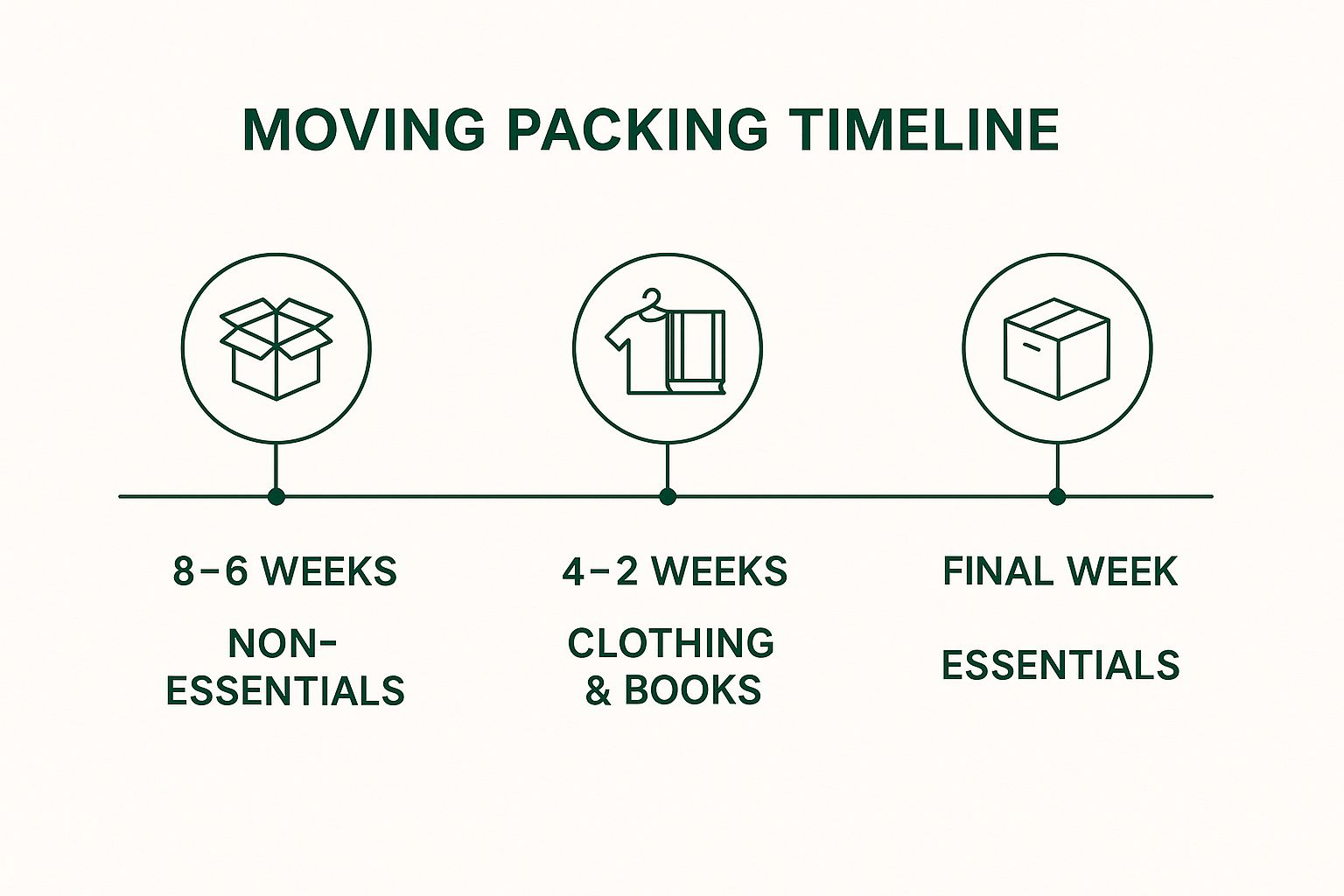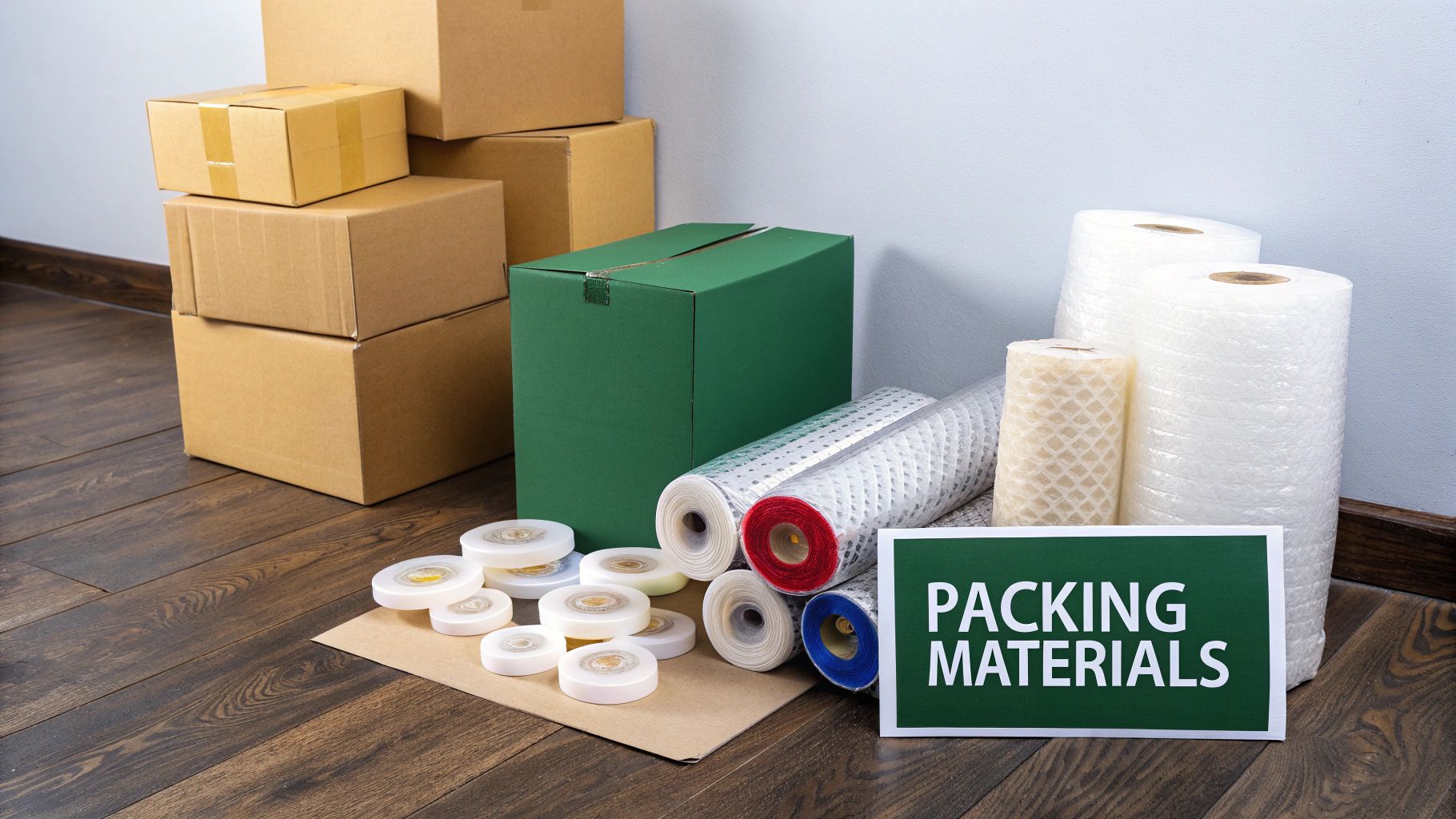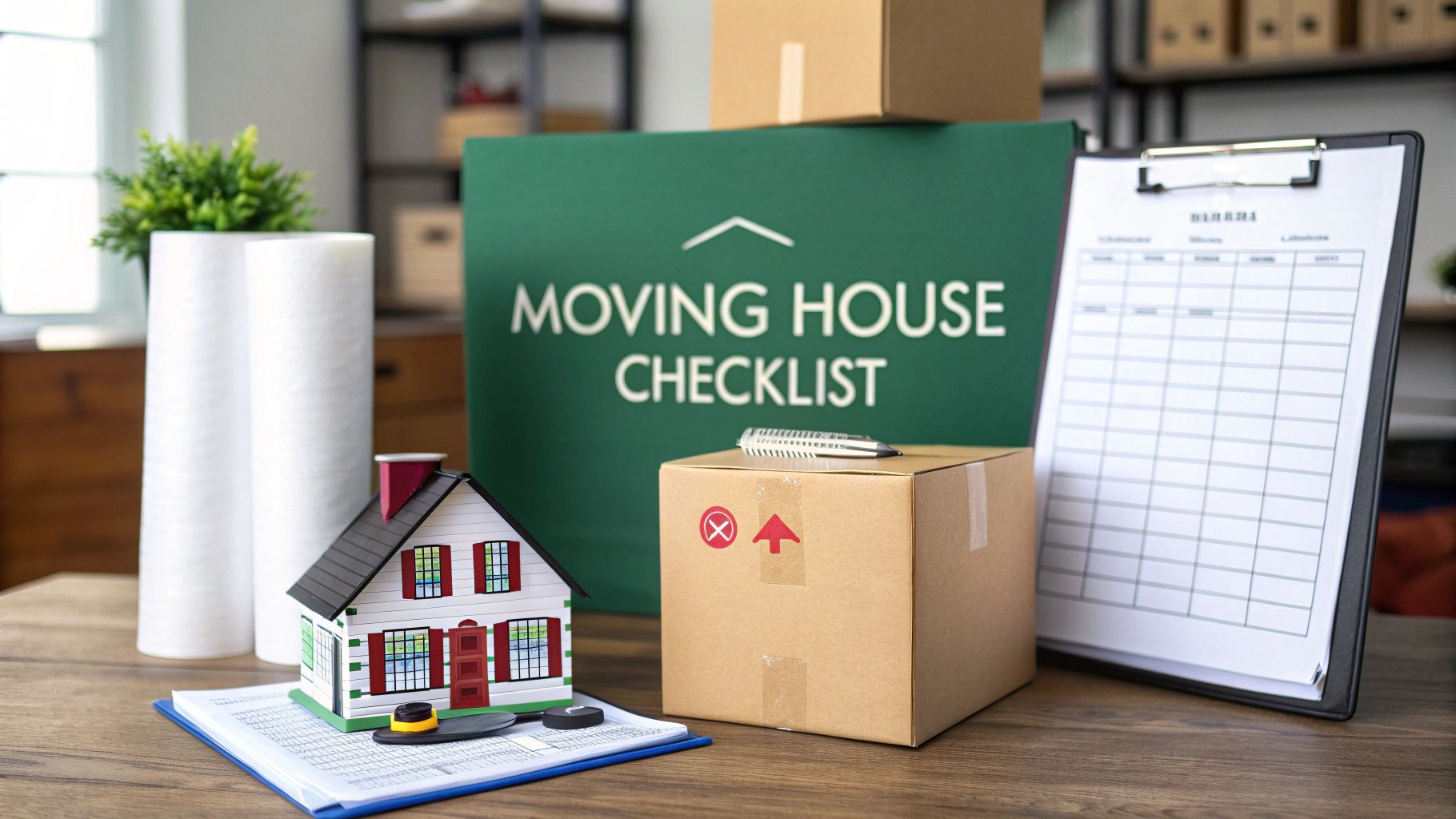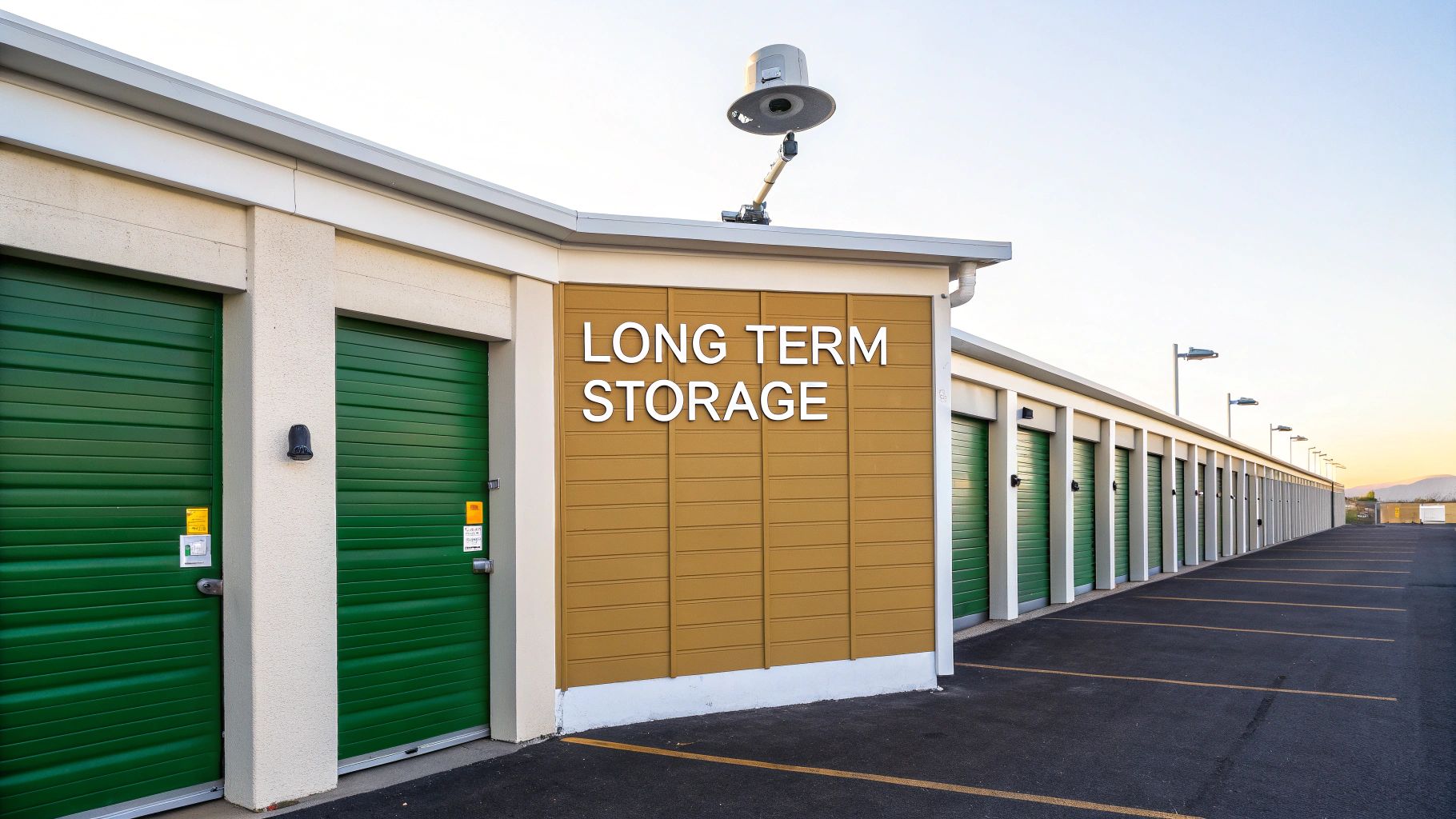Top Tips on Moving House Packing for a Stress-Free Move
Moving house consistently ranks as one of life's most stressful events, but a chaotic relocation is not inevitable. The secret to a seamless transition lies in methodical, well-organised packing. This guide bypasses the generic advice to offer a curated list of actionable, detailed strategies that will transform your move from frantic to controlled. We provide specific, practical tips on moving house packing designed to save you time, reduce stress, and protect your most valued possessions every step of the way.
We will cover everything from establishing a strategic timeline and decluttering effectively to mastering the art of packing fragile items. You’ll learn how to implement a room-by-room strategy, create a foolproof labelling system, and pack an essentials box that will be a lifesaver on moving day. For those embarking on a larger relocation where meticulous planning is even more vital, consulting an ultimate long-distance moving checklist can provide a comprehensive framework to ensure no detail is overlooked. By following these proven techniques, you can approach your move with confidence, ensuring you arrive at your new home with your belongings, and your sanity, perfectly intact.
1. Start Packing Early with a Timeline System
The most common mistake people make when moving is underestimating the time it takes to pack. Starting early with a structured timeline system is one of the most effective tips on moving house packing because it transforms an overwhelming task into a series of manageable steps. This approach prevents the frantic, last-minute rush that leads to disorganisation, damaged items, and unnecessary stress. By creating a clear plan, you can methodically work through your home, ensuring nothing is overlooked.
How a Packing Timeline Works
A packing timeline breaks down the entire process into weekly goals, starting 6 to 8 weeks before your moving day. This systematic method is widely recommended by professional moving companies and is a staple for those who move frequently, such as military families or corporate transferees. The core principle is to pack non-essential items first, gradually working your way towards the everyday essentials you'll need right up until the move.
This structured schedule ensures a steady, stress-free packing experience. Key milestones include:
- Weeks 8–6: Focus on items you rarely use. This includes seasonal decorations, out-of-season clothing, books you won't be reading, and decorative objects from spare rooms.
- Weeks 4–2: Begin packing more frequently used items. This is the time to tackle most of your clothing, kitchenware (except for a basic set), linens, and home office supplies.
- Final Week: This week is reserved for packing only the absolute essentials. This includes your "first night" box with toiletries, a change of clothes, medications, important documents, and basic kitchen supplies.
The following infographic illustrates a simplified version of this packing schedule, highlighting the key phases.

This visual timeline demonstrates how a phased approach prevents last-minute chaos by prioritising tasks based on urgency. Implementing a similar timeline, whether detailed in a notebook or a digital calendar, provides clarity and control throughout the moving process. For more insights on how professionals structure these timelines, you can find valuable information from removal company experts in Exeter to help you plan your move.
2. Declutter Before You Pack
One of the most impactful tips on moving house packing is to declutter before you even think about putting items into boxes. Moving everything you own only to sort it out in your new home is inefficient and costly. A pre-pack declutter reduces the volume of items you need to pack, transport, and unpack, which can significantly lower removal costs and save you immense time and effort. This strategic purge ensures you begin life in your new space surrounded only by things you need, use, and love.

This approach transforms the move from a simple relocation into a fresh start. It is a core principle for professional organisers and is popularised by figures like Marie Kondo, whose methods focus on retaining only items that "spark joy". Similarly, the Swedish Death Cleaning movement encourages a mindful approach to possessions, making it easier for you and your family in the long run. By sorting belongings into distinct categories-keep, donate, sell, or discard-you streamline the entire moving process.
How to Systematically Declutter
The key to a successful declutter is a methodical system. Instead of tackling the whole house at once, work through one room, or even one cupboard, at a time. This prevents you from feeling overwhelmed and allows you to make clear, focused decisions about each item.
Consider these practical steps for an effective pre-move clear-out:
- Apply the One-Year Rule: If you haven't used an item in the last 12 months, it's a strong candidate for removal. This simple rule is highly effective for clothing, kitchen gadgets, and miscellaneous household items.
- Digitise Sentimental Items: For items you cherish but don't have space for, such as children's artwork or old letters, take high-quality photos. This preserves the memory without the physical clutter.
- Organise a Sorting System: Use four designated boxes or areas in each room for items you plan to keep, sell, donate, and throw away. This visual organisation makes the decision-making process much faster.
- Research Donation Benefits: Many charities, like the British Heart Foundation or local furniture banks, welcome pre-move donations. Look into potential gift aid or other benefits for your contributions.
By adopting a decluttering mindset, you not only make packing easier but also cultivate a more organised and intentional living environment. It is a foundational step that sets the stage for a smoother, less stressful move.
3. Use the Right Packing Materials and Box Sizes
Selecting the correct packing materials and box sizes is not just a matter of convenience; it is fundamental to the safety of your belongings. This strategy is one of the most critical tips on moving house packing because it directly prevents damage and streamlines the entire moving process. Using appropriate materials ensures that fragile items are cushioned, heavy items are contained securely, and the moving van is loaded with maximum efficiency, making unpacking a far less daunting task.
Investing in quality supplies, from sturdy boxes to protective wrap, provides a structural foundation for a successful move. Professional removal companies use standardised box systems for this very reason, as it creates stable, stackable units that protect contents from being crushed. Research from industry leaders has shown that proper box selection can significantly reduce the likelihood of damage during transit.

How to Select the Right Supplies
The core principle is to match the box size and packing material to the item's weight, size, and fragility. This prevents boxes from becoming too heavy to lift or collapsing under their own weight. It also ensures that your belongings are properly cushioned against the bumps and jolts of transit.
A well-organised packing strategy involves using a variety of box sizes for specific purposes:
- Small Boxes (approx. 42 litres): Reserve these for your heaviest items. Their compact size prevents you from overpacking them and making them dangerously heavy. They are ideal for books, tools, tinned goods, and vinyl records.
- Medium Boxes (approx. 85 litres): These are the most versatile boxes and will likely make up the bulk of your supply. Use them for kitchenware, small appliances, toys, and electronics.
- Large Boxes (approx. 127+ litres): These should only be used for light, bulky items. Filling them with heavy goods makes them nearly impossible to move safely. They are perfect for bedding, pillows, towels, and large lampshades.
- Speciality Containers: Do not overlook wardrobe boxes for clothing, dish packs with dividers for crockery, and picture boxes for artwork and mirrors. For extremely fragile electronics, consider double-boxing them with ample padding between the inner and outer boxes.
4. Master the Room-by-Room Packing Strategy
One of the most effective tips on moving house packing is to avoid the temptation to pack disparate items from different areas at once. Mastering a room-by-room strategy transforms a chaotic process into a systematic and organised project. This methodical approach involves completing one entire room before moving on to the next, which not only keeps your packing focused but also makes unpacking significantly more efficient. By isolating your efforts to a single space, you reduce the risk of misplacing items and can easily track your progress.
How the Room-by-Room Strategy Works
This strategy is a cornerstone of professional moving services, including corporate relocation and military moves, because of its proven effectiveness in maintaining order. The principle is simple: designate a room, gather all necessary packing supplies, and do not start another area until that room is completely boxed, labelled, and ready to go. This creates self-contained units of packed goods, where everything from a single room stays together.
Adopting this disciplined approach ensures a more logical and less stressful move. Key steps include:
- Start with Least-Used Rooms: Begin with spaces you don’t use daily, such as guest bedrooms, formal dining rooms, or studies. This allows you to make significant progress without disrupting your day-to-day life.
- Create a Staging Area: Use the now-empty room as a staging area to stack sealed and labelled boxes. This keeps hallways and living areas clear and safe.
- Leave Essential Rooms for Last: Pack kitchens, main bedrooms, and children's rooms in the final days before the move to minimise disruption to daily routines.
- Label with Precision: Each box should be clearly labelled not only with its contents but also with its destination room (e.g., "Kitchen – Cutlery," "Master Bedroom – Bedside Lamps").
This structured method prevents the "half-packed" chaos that often derails a move. By focusing your energy one space at a time, you build momentum and a sense of accomplishment. Following a detailed moving house packing checklist can further enhance this strategy by providing a clear, room-specific inventory of tasks.
5. Create a Detailed Labelling and Inventory System
One of the most powerful tips on moving house packing is to treat your move like a professional logistics operation. Creating a detailed labelling and inventory system prevents the chaos of unidentified boxes and the anxiety of wondering if something has gone missing. This methodical approach ensures every box is accounted for, easy to place in the correct room, and simple to unpack, saving you immense time and stress upon arrival at your new home.
How a Labelling and Inventory System Works
This system involves more than just scribbling "Kitchen" on a box. A robust method assigns a unique number to each box and pairs it with a corresponding inventory list, either in a notebook or a digital spreadsheet. This is a standard practice for professional removal companies and is essential for complex moves, such as those involving long-term storage or international shipping where detailed manifests are required. The goal is to create a clear, searchable record of your belongings.
This organised system makes locating specific items effortless. Key components include:
- Comprehensive Labels: Each box label should include the box number, the destination room (e.g., "Master Bedroom," "Kitchen"), a brief summary of the contents ("Pots and Pans," "Winter Jumpers"), and any special handling instructions like "FRAGILE" or "THIS WAY UP."
- Master Inventory List: Your inventory list should have columns for the box number, its contents, and its destination room. You can tick off each box as it is loaded onto the van and again as it is unloaded at your new property.
- Colour-Coding: Assign a different coloured marker or sticker to each room. This provides a quick visual cue for movers, helping them place boxes in the correct location without needing to read every label.
By adopting this system, you gain complete control over your possessions. You'll know exactly what you have, where it is, and where it's going. The principles of creating such a system are similar to those used in commercial settings, and you can learn more about how detailed tracking is applied by reading about inventory management for small businesses. This level of organisation transforms a potentially chaotic move into a smooth, manageable project.
6. Pack an Essentials Box for Moving Day
After weeks of packing, the last thing you want is to be rummaging through dozens of sealed boxes for a toothbrush or phone charger on your first night in a new home. One of the most crucial tips on moving house packing is to prepare a dedicated "essentials box". This survival kit contains everything you and your family will need for the first 24 to 48 hours, ensuring a smooth and comfortable transition without the stress of immediately unpacking everything.
This concept is inspired by the meticulous planning seen in various professional sectors. For instance, the hotel industry prepares emergency kits for unforeseen circumstances, and military families often use a version of a ‘holdall’ adapted for moves. The principle is simple: isolate critical items to maintain a sense of order and normality amidst the chaos of moving day. By having these essentials within easy reach, you can focus on settling in, not searching for necessities.

How to Create Your Moving Day Essentials Box
Creating an effective essentials box involves thinking ahead about your immediate needs. Treat it as if you are packing for a short trip to an unfurnished location where you have no access to your other belongings. This box should travel with you personally, in your car, rather than being loaded onto the removal lorry.
Here’s a practical checklist of what to include for a stress-free first night:
- Personal Items: A change of clothes for everyone, toiletries (toothbrush, toothpaste, soap), and any prescription medications.
- Kitchen Basics: Kettle, mugs, coffee or tea, snacks, paper plates, cups, and cutlery. A small bottle of washing-up liquid and a tea towel are also invaluable.
- Important Documents: Passports, driving licences, property documents, and moving company paperwork. Keep these secure and accessible.
- Tools and Technology: A basic tool kit (screwdriver, hammer), phone chargers, a torch, and perhaps a portable speaker to make the unpacking feel less like a chore.
By setting these items aside, you ensure your first day and night in your new home are organised and comfortable. This simple preparation step eliminates a major source of moving-related stress, allowing you to settle in at your own pace.
7. Use Smart Packing Techniques for Fragile Items
Protecting your delicate belongings from damage during transit is a critical concern, and employing specialised packing methods is one of the most important tips on moving house packing. Standard packing won't suffice for glassware, electronics, or artwork. Smart packing techniques, borrowed from professionals like art handlers and antique dealers, involve using the right materials and strategic box arrangements to create a protective system that absorbs shock and prevents breakage. This ensures your most treasured items arrive in perfect condition.
How Smart Fragile Packing Works
The principle behind smart packing is to create multiple layers of protection and eliminate any empty space within the box where items could shift. Professional moving companies and even electronics manufacturers use these methods to guarantee safe transport. It involves more than just bubble wrap; it's a systematic approach that considers the unique vulnerabilities of each item, from the shape of a vase to the sensitivity of a computer screen.
This organised approach prevents breakages and provides peace of mind. Key techniques include:
- Wrap Individually: Every fragile item, especially dishes and glasses, should be wrapped individually in packing paper or bubble wrap before being placed in the box.
- Pack Vertically: Plates, platters, and artwork are stronger when positioned on their edges, like records in a crate. Packing them flat makes them far more susceptible to cracking under pressure.
- Fill Empty Spaces: Fill hollow items like glasses and vases with crumpled packing paper. Use more paper, towels, or packing peanuts to fill any gaps in the box to prevent items from moving.
- Clearly Label Boxes: Mark boxes containing fragile items clearly on all sides and the top with "FRAGILE" and "THIS WAY UP". This instructs movers on how to handle and stack the boxes correctly.
By adopting these professional-grade techniques, you create a secure environment for each delicate piece, significantly reducing the risk of costly and heartbreaking damage. This method turns a potentially stressful part of moving into a controlled, confident process.
8. Optimise Heavy Items with Strategic Packing
Incorrectly packing heavy items is a common and costly moving mistake, leading to personal injury, broken belongings, and box failure. One of the most critical tips on moving house packing is to optimise how you handle these dense objects. This involves using specific techniques for everything from books and tools to small appliances, ensuring they are transported safely and efficiently. By adopting a strategic approach, you prevent back strain and ensure your boxes can withstand the weight.
How to Pack Heavy Items Effectively
The core principle behind packing heavy items is to distribute weight intelligently rather than simply filling the largest box you can find. Professional removal services and even library moving specialists perfect this technique to manage substantial weight without incident. The goal is to keep each box manageable for one person to lift, protecting both the mover and the box's contents.
This method requires a counterintuitive approach: use smaller boxes for your heaviest items. Key strategies include:
- Small Box Rule: Pack dense items like books, tools, tinned goods, or dumbbells in small boxes. This naturally limits the total weight you can fit inside.
- Weight Capping: Never let a box exceed 22 kg. A good rule of thumb is if you struggle to lift it, it’s too heavy.
- Mix and Match: To balance weight in medium-sized boxes, place a few heavy items at the bottom and fill the rest of the space with lighter things like towels or cushions.
- Specialised Techniques: When packing books, place them flat or with spines alternating up and down to distribute weight evenly and prevent damage.
For extremely heavy or bulky items, using the right equipment is non-negotiable. Using a dolly or a sack barrow can save significant physical effort and reduce the risk of injury. When planning your move, understanding specialised equipment is crucial; for instance, you may want to research if you need a What Is Liftgate Service for easier loading and unloading of particularly cumbersome objects.
Properly organising these heavy boxes is just as important as packing them. When placing them in a removal van or storage unit, always position them at the bottom to create a stable base for lighter boxes. To get a better understanding of this, you can learn more about how to correctly stack your belongings from our expert guide on packing a storage unit.
8 Key Tips Comparison for Moving House Packing
| Strategy | Implementation Complexity | Resource Requirements | Expected Outcomes | Ideal Use Cases | Key Advantages |
|---|---|---|---|---|---|
| Start Packing Early with a Timeline System | Moderate (requires discipline and planning) | Time for advance planning and task management | Reduced stress, better organisation, less damage risk | Long-distance moves, busy schedules | Prevents last-minute rush, quality packing |
| Declutter Before You Pack | Moderate to High (decision-heavy) | Time and emotional effort | Lower moving costs, less clutter, faster unpacking | Moves involving downsizing or fresh start | Cost savings, earns from selling, less unpacking |
| Use the Right Packing Materials and Box Sizes | Moderate (need to acquire and manage supplies) | Purchase of quality materials | Reduced damage, efficient packing, professional look | Fragile or valuable items, organised packing | Damage prevention, easier stacking/loading |
| Master the Room-by-Room Packing Strategy | Moderate (requires order and discipline) | Time for systematic packing | Organised unpacking, less lost items | Moves where systematic unpacking is necessary | Clear organisation, easier tracking |
| Create a Detailed Labelling and Inventory System | High (time-intensive and detail-focused) | Time for labelling and inventory tracking | Faster unpacking, fewer lost items | Large moves, moves with many boxes/valuables | Speeds unpacking, aids insurance claims, precise tracking |
| Pack an Essentials Box for Moving Day | Low to Moderate (focused packing effort) | Minimal; select essential items | Immediate access to essentials, reduced stress | All moves, especially first 1-2 days in new home | Eliminates frantic searching, provides peace of mind |
| Use Smart Packing Techniques for Fragile Items | High (requires skill and materials) | Specialised packing materials | Significantly reduced damage to fragile items | Moves with valuable fragile belongings | Protects valuables, reduces breakage |
| Optimise Heavy Items with Strategic Packing | Moderate (planning and cautious packing) | Smaller boxes, possibly equipment | Safer handling, less box damage and injury | Moves including heavy books, tools, appliances | Prevents injury, better weight distribution |
Packing Complete: Your Next Chapter Awaits
Navigating the complexities of moving house can feel like a monumental task, but with a strategic approach, it transforms from a source of stress into a manageable project. By breaking down the process into deliberate, actionable steps, you've equipped yourself with the tools to handle the challenge with confidence. The various tips on moving house packing we've explored are more than just a checklist; they form a comprehensive framework for an organised and efficient transition. From the initial decluttering phase and creating a detailed timeline to mastering the art of packing fragile items and labelling with precision, each piece of advice works in concert to streamline your move.
The true value of these strategies lies in their cumulative effect. Starting early doesn’t just prevent last-minute panic; it creates the space to declutter meaningfully. Using the correct materials isn’t just about protection; it's about making the most of every box and every bit of lorry space. Similarly, a robust labelling system isn't just for identification; it's the key to a logical, stress-free unpacking process that gets your new house feeling like a home in record time. Remember, the goal is not merely to transport your belongings from one location to another. It is to set the stage for a positive and organised start in your new environment.
Key Takeaways for a Seamless Move
To ensure your efforts pay off, keep these core principles at the forefront of your mind:
- Preparation is Paramount: The success of your move is directly proportional to your level of preparation. An early start, a clear plan, and a thorough inventory system will mitigate nearly every common moving day headache.
- Work Smarter, Not Harder: Employing smart techniques, such as the room-by-room strategy, using smaller boxes for heavy items, and protecting valuables with proper cushioning, saves you time, energy, and potential breakages.
- The Essentials Box is Non-Negotiable: This single box is your lifeline during the first 24 hours. Packing it thoughtfully ensures you have immediate access to everything you need, from toiletries and chargers to coffee and essential documents, without having to rummage through a sea of boxes.
With your possessions now expertly packed and organised, you can focus on the final details of leaving your old space and preparing the new one. Once your packing is complete, you might also consider professional services to ensure both properties are in pristine condition. For instance, you might want to quickly get a home cleaning estimate to handle the final clean-up, freeing you to concentrate on settling in. By mastering these tips on moving house packing, you have laid the groundwork for a smooth transition, allowing you to close one chapter with peace of mind and open the next with genuine excitement.
Feeling overwhelmed by clutter or need a secure space for your belongings during the move? At MG Self Storage in Exeter, we offer flexible, secure storage solutions and a fully-stocked box shop to support every stage of your transition. Visit us online at MG Self Storage to find the perfect unit for your needs.








